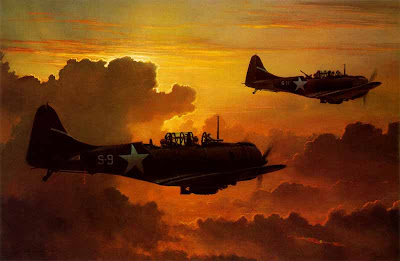Midway 66 Years Later – Lessons Learned
 “I can run wild for six months … after that, I have no expectation of success.“
“I can run wild for six months … after that, I have no expectation of success.“
– Fleet Admiral Isoruku Yamamoto
In racing there is a saying – ‘luck is where preparation meets opportunity’ Perhaps there is no truer an example than the Battle of Midway. Popular literature seems to emphasize the American forces stumbling into a heaven-sent scenario of laden carrier decks and little to no opposition to the dive bombers, while giving short shrift to the preparation that enabled them to make use of that opportunity. How so?
COMINT: Communications Intelligence – the US code breakers labored mightily to figure out what the IJN was up to. Were it not for their efforts prior to Midway, and some particularly inspired thinking and risk taking, the US may well have fallen for the feint up to Alaska and end up caught in the trap laid by Yamamoto.
Damage Control: Had the crew of the Yorktown not been so proficient in DC, particularly something as seemingly mundane as draining the avgas lines and filling them with inert gas prior to the battle of Coral Sea, the Yorktown may very well have been lost, leaving CINCPAC with only two carriers facing four, forcing a different battle plan. Conversely, the almost lackadaisical approach the Japanese took in repairing Shokaku’s damage or replinishing Zuikaku’s air wing and repairing her light damage from Coral Sea’s action ensured their nonavailability for Midway, keeping the balance of forces on a razor’s edge.
Training: The contrast between USN and USMC effectiveness in employing dive bombers at Midway was signatory. Using the same platform (SBD-3’s) USN pilots scored major hits while minimizing losses to AAA and fighters, whereas the Marines suffered significant losses for little, if any gain. The difference? Tactics, training and procedures or TTP (yes, we know -ugh, one of those modern terms…) – the Navy employed steep, usually 70-degree, dives on the target whereas the Marines used much shallower, gliding approaches. The former minimizes your exposure time and profile to AAA and fighters while increasing the likelihood of a hit. However, it requires considerable practice at obtaining the proper dive angle, avoiding target fixation and knowing how/when to pullout of the dive and avoid over-stressing the airframe. Lots of practice, underscoring the maxim about training like you are going to fight…
Employment of forces: The Japanese were the first to employ massed striking power using carriers and the strike at Pearl (and subsequent actions through SE Asia and the IO) validated the philosophy. The problem was the Japanese failed to comprehend the inherent flexibility of carrier-based air and thus eschewed opportunities to utilize it in other scenarios, such as scouting, which in turn, led to less than robust search plans and reliance on out-dated search aircraft and methodologies. Curiously, the Japanese broke this rule in planning the Aleutian invasion, diverting forces on a mission of questionable value and success for territory that would prove to be exceptionally harsh on man and machine while yielding little, if any strategic value outside of propaganda for an overly wrought plan of entrapment. This leads to questions of planning…
Planning/Command: In studied contrast to the run-up at Pearl, Japanese planning for Midway was poorly thought out, egregiously evaluated and gamed and haphazardly executed (cf: the entire submarine picket plan). Indeed, it was put together and executed in such a toxic atmosphere of arrogance and bluster that even when one of the final wargame sessions showed American forces gaining an upper-hand because of gaps in the air search pattern, referees for the wargame manipulated the environment and other factors to bring about a successful conclusion for Kido Butai. As for dealing with changing factors at sea, commanders were loath to step outside the boundaries of the plan and demonstrate initiative. In studied contrast were the actions of the Americans from Nimitz’s orders based on calculated risk to Dick Best’s last minute change in targets.
Luck indeed smiled on the Americans that day, but she did not grab them by the hand (or scruff of the neck) and tell them what must be done in PowerPoint bulletized format. She merely opened the door, a crack, and offered a fleeting moment to change the course of the battle…the Americans grasped it and changed the direction of the war. Review the list above – these are timeless lessons learned, every bit as applicable today as they were 66 years ago. My observations lead me to believe we are ignoring them at our future peril. – SJS


Great analysis. I linked to it at OP-FOR.
………one of the final wargame sessions showed American forces gaining an upper-hand because of gaps in the air search pattern, referees for the wargame manipulated the environment and other factors to bring about a successful conclusion for Kido Butai.
A salutory lesson for our own wargames, it has been a regular source of frustration in exercises when rather than pressing on to see how best to respond to something of this sort and then learning from it, to see exercise control reset the game because it would either interefere with the event cycle progression or “that couldn’t happen”. I would much rather let the thing run out, annotate it for discussion and then go back and do it without whatever event supposidly couldn’t happen than just pretend the bad guys aren’t just as smart and creative as we are. I realise these things are expensive to run, but the real losses in a live situation, would be far more so if we choose to ignore these possibilities. Plan Orange never worked out the way we thoguht it would, either….
Strange side note to Midway, Dick Best and fellow participant Dick Wolf, by then both commanders, were neighbors at NAS Pt Mugu in the mid 1960s.
Well thought out analysis. Midway, which came only six months after Pearl Harbor (almost to the day) marked both the end of the beginning of the war in the Pacific, and the beginning of the end for Japanese ambitions.
Intelligence was, in fact, the crucial key that gave Adm Nimitz the ability to ambush and defeat a superior force. But each of your other elements were also essential to the victory.
Japanese planning throughout the war seemed to depend on vastly complex plans that hinged on multiple events occuring sequentially, and , as we all know, no plan survives contact.
Adm Nimitz, on the other hand, believed in the “find’em, fix’em, fight’em, finish’em” philosophy.
The victory at Midway was paid for by the crews of the USN torpedo planes who drew down the Japanese Zeros to wavetop level allowing the USN dive bombers to kill the Jap carriers. Those guys made it to the Pearly Gates just in time to watch the show below. Their courage and the courage of the P-38 Lightning pilots who gunned Yamamoto down later in the war were instrumental in the US final victory. For some reason, I
always remember the last line in the Bridges at Toko-Ri…..
“Where do we get such men?”
That pretty much sums it up.